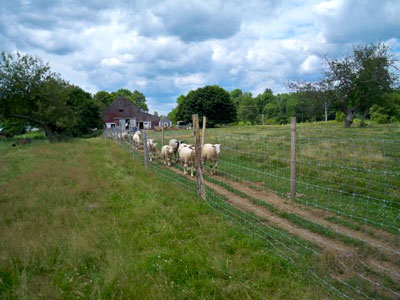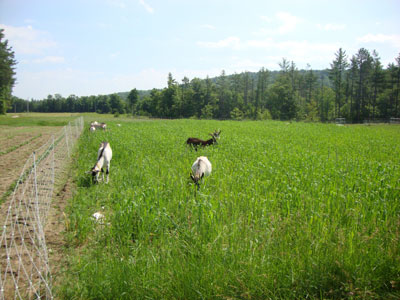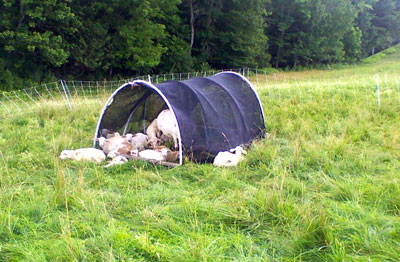 |
| A well-made lane guides sheep to pasture at Susan Littlefield’s Yknot Farm in Belmont, Maine, which is transitioning to organic. Photo by Diane Schivera. |
By Diane Schivera, M.A.T.
Raising sheep and goats organically can be a challenge, so many farmers who support organic principles have not transitioned their animals to certified organic. Presently MOFGA Certification Services certifies four sheep and two goat farmers. To help farmers who are interested in transitioning, MOFGA will hold a meeting (with refreshments) on Wednesday, October 24, at 6 p.m. at MOFGA’s Common Ground Education Center in Unity, to discuss issues and concerns about transitioning.
Among the issues that farmers cite as hurdles to becoming certified are internal parasite control, control of foot rot, other medical issues, the cost of organic grain, and overall profit.
Internal Parasite Control
Small ruminants are particularly susceptible to internal parasite infestation – primarily from Haemonchus contortus and coccidia in Maine.
Coccidia affects young stock; after about six months, most animals develop immunity. Keeping animals in a clean environment works wonders. A product called Regano from Ralco Nutrition, Inc., has effectively controlled coccidia.
Because some populations of Haemonchus or barberpole worm have become resistant to one or all conventional parasitcides, this parasite is more difficult to control and requires a multi-prong approach. Most of those prongs are permitted in organic production.
Reduce contact of young animals with stage 3 larvae. This stage can occur on pasture, paddock or in a well-bedded barn where the parasite can develop over a period of two to four weeks, depending on moisture and temperature, from an egg in the feces to the infective stage. Within three weeks, ingested larvae have matured to egg-producing adults. Keep the barn well bedded so that the top is dry to reduce the ability of larvae to travel to the top of the bedding. Set up pasture rotations so that animals do not return to the same pasture for more that four weeks – a year is even better, especially for lambs.
Don’t let lambs or adult sheep graze lower than 2 inches on pasture plants; this helps reduce infestation because larvae cannot crawl higher that 2 inches up the plant.
 |
| Goats at Little Falls Farm in Harrison, Maine, a MOFGA-certified organic farm, have grazed down the oats in this field, leaving the vetch to take off. Photo courtesy of John and Mary Belding. |
Don’t graze wet pasture, because larvae crawl on wet blades of grass more easily and hang out in water drops.
Medicinal plantings in your pasture or hedgerow can help. Plants that are high in tannins, such as evergreens, sanfoin, birdsfoot trefoil, Sericea lespedeza and chicory, are some possibilities. These plants have been studied somewhat for parasite control but more research is needed.
Jean Noon, a MOFGA-certified organic sheep producer, researched the use of Garlic Barrier for parasite control. It has proven very helpful in many situations. (“Controlling Sheep Parasites with Garlic Juice,” by Jean Noon, The MOF&G, Winter 2004/2005)
Wendy Pieh uses a product called Copasure with her cashmere goats. This supplement consisting of copper oxide wire particles comes in boluses large enough for cattle. Pieh makes them into smaller, 2-gram boluses for her goats.
Learn to evaluate animals’ health by using body condition scoring, FAMACHA (a simple way to diagnose parasite infection in sheep and goats) and by getting a microscope for fecal egg counts (FEC).
Good nutrition helps animals stay in good shape while developing immunity.
Sheep and goats’ genes affect their ability to develop immunity, and these genetics can be passed to their offspring. When deciding which young animals to keep, choose those from mothers that are surviving well under your management system – e.g., from moms that require little or no worming and have low FEC or FAMACHA scores.
Stock density (size of flock or herd in relation to the land base) on your pastures affects the economics and parasite control of your operation. If you can feed your animals primarily on pasture during the season, you’ll purchase less feed – and parasite control improves with a stock density that is low enough to allow effective pasture rotations.
Foot Rot
 |
| This shelter at Ann and Andrew Mefferd’s One Drop Farm in Cornville, Maine, a MOFGA-certified organic farm, sits on 2 x 4 skids with angled tips on both ends so that the structure can be dragged in either direction by tying rope to either side. Two cross pieces of smaller dimension lumber connect the skids. The 3/4-inch schedule 40 PVC hoops are screwed on with pipe straps, supported with one ridge pole and covered with two layers of 60 percent shade cloth. Photo by Ann Mefferd. |
Foot rot is worse when animals’ feet are continuously wet. It is caused by the combination of two bacteria – Fusobacterium necrophorum, which is in nearly all sheep environments, and Dichelobacter nodosus, which is introduced by carrier sheep or visitors’ feet. Together they produce nasty, smelly foot rot.
Individually each bacterium, as well as Actinomyces pyogenes, causes a milder form of the disease called foot scald, common in sheep and goats but less infective in dry environments.
Both foot rot and foot scald are treated with copper sulfate powder, permitted under organic certification. As with parasite resistance, a genetic link exists to foot rot susceptibility. Be aware with your breeding.
The sidebar with this article gives a foot rot control protocol formulated by Richard J. Brzozowski, Dr. Charles Parker, Dr. Tom Settlemire and Dr. Anne Lichtenwalner. This protocol is part of a study Brzozowski is conducting. For more information, contact him at 1-800-287-1471, [email protected], or see https://umaine.edu/sheep/foot-rot/foot-rot-or-scald/. Organic farmers must substitute copper sulfate for the zinc sulfate.
Other Medical Issues
Sheep and goat farmers considering transitioning are also concerned about other medical issues and the inability to use antibiotics or other non-permitted substances. Often flocks and herds are small and individual animals are much more precious, so culling is more of an issue, because quality replacement stock is not very available. For information about alternative healthcare practices, see MOFGA’s fact sheet “Raising Organic Livestock in Maine.” MOFGA Certification Services has a list of allowed products.
Economics
The price of grain is another concern. Fifty-pound bags of organic grain can cost up to twice the conventional price; but recent bulk prices for a goat grain were $650/ton (or $26 for 88 pounds) for a non-GE, conventional grain from Sure Gain in Canada vs. $722/ton for locally milled, organic grain from Maine Organic Milling, so the price differential is markedly lower for bulk products.
Another way to reduce grain expenses is to grow and feed a healthy pasture and limit or eliminate grain consumption. This can be done from at least mid-May to the end of September – and longer, by planting frost tolerant crops. Some sheep farmers plant fall brassicas – such a nutrient dense crop that it is used to flush the sheep instead of feeding grain.
The last concern is whether the price farmers can charge for their organic product will compensate for the higher production costs. MOFGA-certified organic sheep and goat producers have profited by keeping good expense records, creating a budget, evaluating costs and educating customers about the value of their products and production methods.
The key is to plan for profit. Calculate how much money you need to make from each farm enterprise and plan your expenses accordingly. Some bills must be paid, but look seriously at others. Do you really need to buy another roll of fence, or can you get by this year and buy it next year from this year’s profits? If you are flushing with grain, are you making enough from the sale of the young stock or related product to cover that cost and make a profit, or would it be more profitable to flush on good pasture and not spend that extra cash on grain?
Good resources about raising sheep and goats are www.sheepandgoat.com/ and fiascofarm.com/goats/index.htm.
Controlling Foot Rot
Based on recommendations by Richard J. Brzozowski et al.
Note: Organic farmers must substitute copper sulfate for the zinc sulfate.
Day 0 (First Day)
Trim the feet of each animal.
Score each hoof to indicate a healthy foot, a foot that is infected or one that has structural abnormalities; score hoof color. A score sheet is available at https://umaine.edu/sheep/foot-rot/foot-score-record-sheet/.
Place animals in a foot bath, which can be part of a working chute or can be larger so that several animals can be treated at once. The bath is a 10 percent zinc sulfate solution and detergent (8.5 pounds zinc sulfate powder/10 gallons of water + 1 cup detergent). Old wool placed in the bottom of the foot bath creates the best “soaked pad” to reduce splashing and loss of zinc sulfate solution. Each sheep needs to stay in the bath for 3 to 5 minutes. Then the sheep should be separated into a healthy, infection-free group and an affected/recovery group (candidates for possible culling). Sheep in each group should be color coded with a suitable livestock marker. These sorted sheep are then placed in one of two designated drying areas (a well-bedded barn area or dry, hard surface, such as a clean concrete pad or wooden floor) for at least 30 minutes.
Each group is then moved to separate pastures or barn areas where sheep have not been for two weeks (the length of time the causative bacteria for foot rot can live outside contact with sheep).
DAY 7
Treated all sheep with a foot bath and drying protocol as described above.
Carefully observe sheep in the Healthy Foot Group. Inspect any that are limping. If any infection is found, trim feet if necessary and move these sheep to the Recovery Group.
DAY 14
Confine all sheep, score each hoof and record the score. Check and trim hooves as needed. Animals in the Recovery Group that have healed and show no signs of infection or foot abnormality can be moved to Healthy Foot Group. Move any sheep in the Healthy Group that show any infection or suspicious feet to the Recovery Group.
Treat all sheep with a foot bath and drying protocol as described above.
Move each group to separate pastures or areas where no sheep have been for two weeks.
DAY 21
Treat all sheep with a foot bath and drying protocol as described above.
Carefully observe sheep in the Healthy Foot Group. Inspect any that are limping. If any infection is found, trim feet if necessary and move these sheep to the Recovery Group.
DAY 28
Inspect all sheep, score each hoof and treat all animals with the foot bath and drying protocol as described above.
By now, the combination of proper trimming, zinc sulfate treatment and use of clean pastures will have allowed time for all sheep except carriers to heal. Animals that have not healed and animals classified as carriers should be culled. Culling is crucial to creating and maintaining a flock free of foot rot.
Diane Schivera is MOFGA’s organic livestock specialist. You can contact her at 568-4142 or [email protected].
